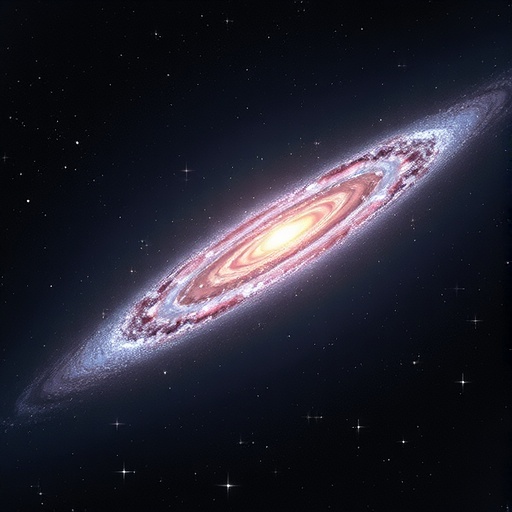In a remarkable achievement for astronomy, a team of researchers has captured unprecedented images of the interstellar comet 3I/ATLAS, utilizing the advanced capabilities of NASA’s Hubble Space Telescope. This stunning telescope, renowned for its exceptional vision, provided the sharpest observations of 3I/ATLAS when it was a staggering 277 million miles away from Earth, photographing it on July 21, 2025. The images showcase a teardrop-shaped cocoon of dust trailing off the comet’s solid and icy core, emphasizing the unique characteristics that define this cosmic visitor.
The comet, traveling through our solar system at a breathtaking speed of 130,000 miles per hour—making it the fastest solar system visitor ever recorded—has generated considerable intrigue among astronomers and space enthusiasts alike. Such velocity suggests that it has been roaming interstellar space for eons, possibly billions of years, propelled by gravitational forces from numerous stars and other celestial bodies it has encountered on its journey. Unlike comets originating in our solar system, 3I/ATLAS’s trajectory can be described as hyperbolic, suggesting a distinct and unpredictable origin.
Hubble’s observations allow astronomers to refine their estimates regarding the comet’s nucleus size, revealing an upper limit diameter of 3.5 miles, while possibly being as small as 1,000 feet. Although the core remains elusive and obscured in the brightness of its dust envelope, Hubble continues to hone our understanding of this remarkable interstellar body. With additional observations slated from other NASA missions—including the James Webb Space Telescope and the Neil Gehrels Swift Observatory—there is great anticipation to unveil further details about the comet’s composition and potential origins.
In conjunction with the compelling images of 3I/ATLAS, Hubble also documented a dust plume fomented by the heat of the Sun that appears to emerge from the comet. The data indicate a dust-loss rate reminiscent of comets first detected at distances similar to that of 3I/ATLAS from the Sun, affirming behaviors aligned with previously observed comets in our own solar neighborhood. This sedimentary activity underlines the dynamic nature of the comet as it interacts with solar radiation, highlighting its ongoing evolution as it travels through the solar system.
One notable observation made by astronomers is the resemblance of 3I/ATLAS to some comets originating from within our own solar system. Such parallels emphasize the shared characteristics that could provide critical context to the study of cometary bodies, revealing whether interstellar visitors may possess physical attributes akin to their solar counterparts. However, it’s crucial to acknowledge the profound differences that set 3I/ATLAS apart, notably its non-solar origin from an unknown stellar system, eluding precise identification.
David Jewitt, an esteemed astronomer at the University of California, Los Angeles, and principal investigator for the Hubble observations, articulated the enigma surrounding the comet’s journey. He likened viewing 3I/ATLAS to glimpsing a high-velocity projectile, emphasizing the challenges in tracing back its cosmic trajectory and true origins—underscoring the intertwined complexities of celestial mechanics and astrodynamics.
The comet’s discovery by the NASA-funded Asteroid Terrestrial-impact Last Alert System (ATLAS) on July 1, 2025, at a distance of 420 million miles from the Sun, marked a significant milestone in the ongoing exploration of interstellar bodies. The ATLAS initiative serves as an early warning mechanism for asteroid impacts, and its identification of 3I/ATLAS represents an important contribution to the growing body of knowledge regarding such wandering celestial artifacts.
Researchers have posited that this is just the beginning of unveiling a previously obscured population of interstellar objects. Astronomers, equipped with cutting-edge observational technology, are poised to uncover further intriguing specimens that traverse our solar system, shedding light on their formation and characteristics. Each successive discovery adds to our understanding of cosmic evolution while opening exciting avenues of research into the fabric of our galaxy.
Even as the comet approaches an unseen proximity to the Sun, where its brightness may hinder future observations, expectations remain high for further insights as it will become visible again later in the year. The cosmic journey of 3I/ATLAS exemplifies the mysteries lurking beyond our immediate celestial neighborhood, promising to enrich our conception of the universe and our place within it.
The collaborative effort between NASA and international partners, along with the continued operation of the Hubble Space Telescope, will pave new paths in the search for knowledge about our cosmic surroundings. As investigations proceed, the findings from this remarkable interstellar encounter are destined not only to invite curiosity but also to ignite the imagination concerning the vastness of space and the mysteries still waiting to be unveiled.
Furthermore, as our understanding of interstellar comets like 3I/ATLAS evolves, researchers will turn their attention to the potential implications these objects hold for solar system formation theories. This serves to inspire a generation of astronomers and physicists, rekindling a sense of wonder about the natural world and the mechanisms behind the profound phenomena we observe in our galaxy and beyond.
Subject of Research:
Article Title: Hubble Space Telescope Observations of the Interstellar Interloper 3I/ATLAS
News Publication Date: July 2025
Web References: NASA
References: The Astrophysical Journal Letters
Image Credits: NASA, ESA, David Jewitt (UCLA); Image Processing: Joseph DePasquale (STScI)
Keywords
Interstellar comet, Hubble Space Telescope, 3I/ATLAS, astronomers, interstellar, cosmic, celestial mechanics, dust plume, NASA, solar system.




